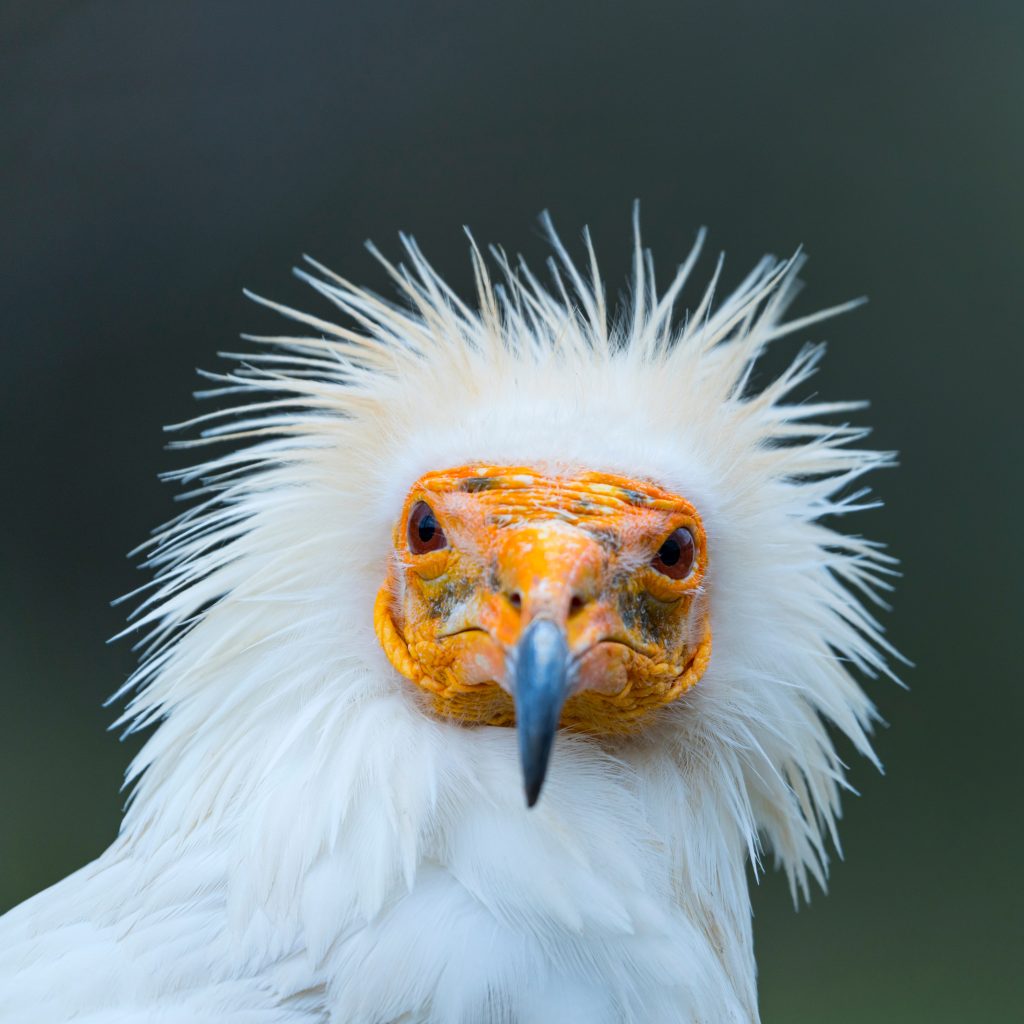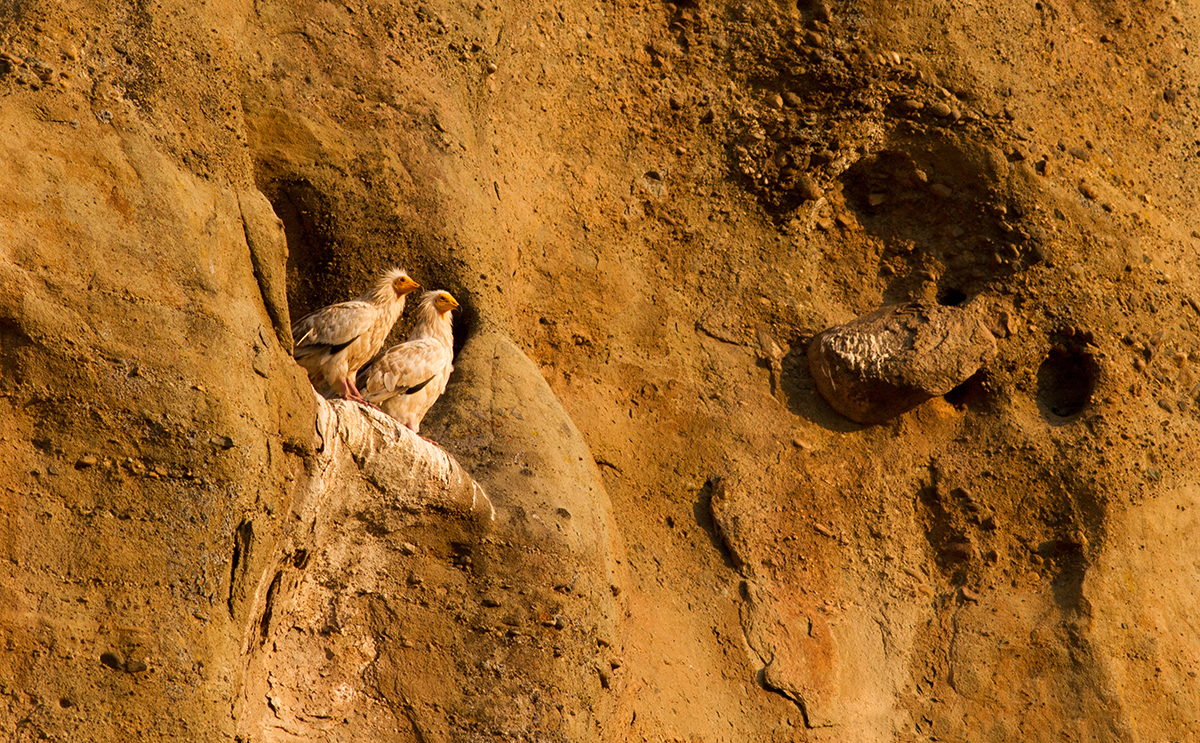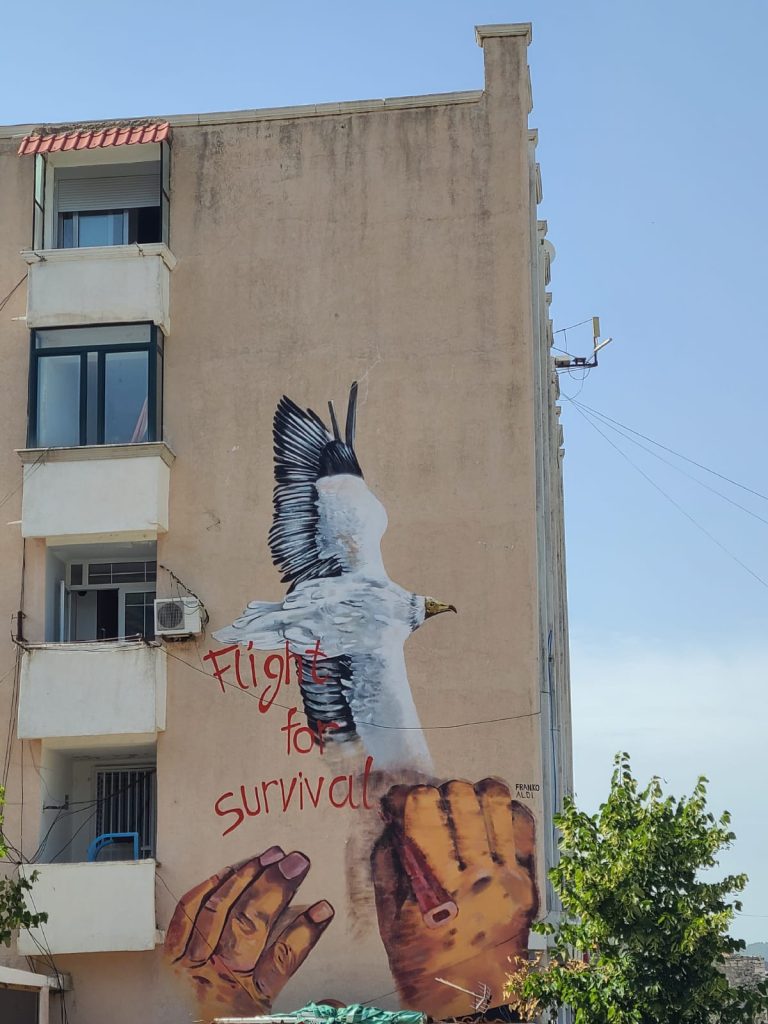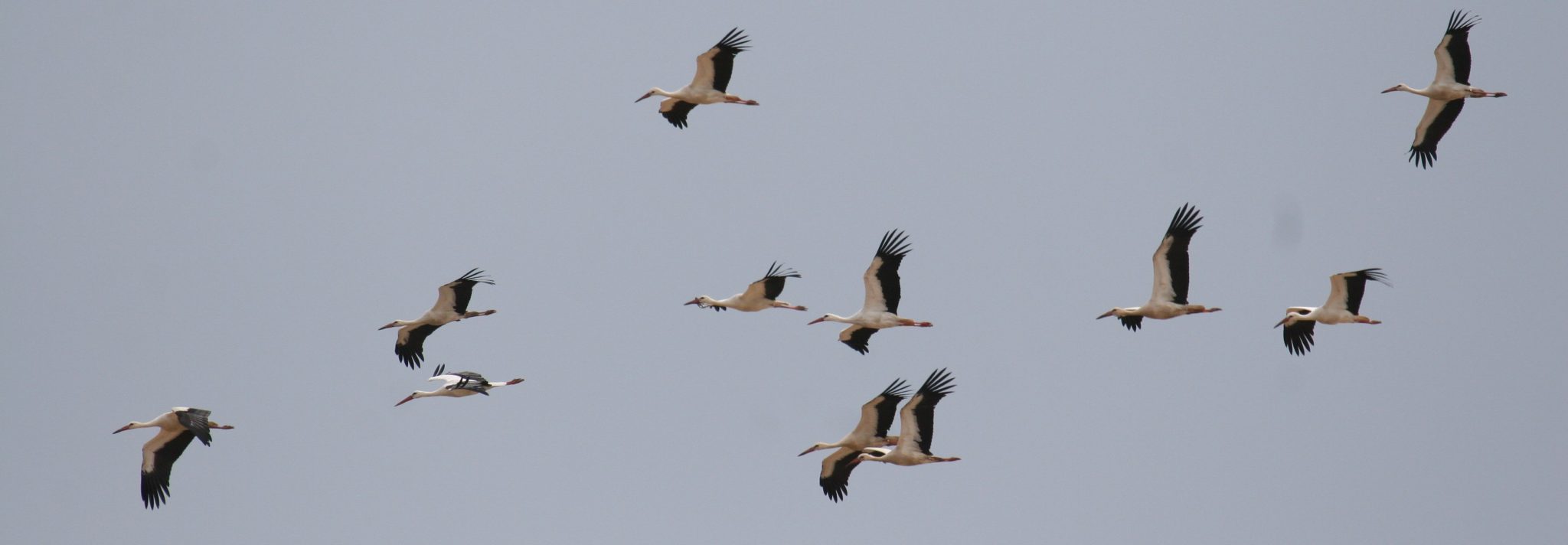Migratory bird of the month: Egyptian Vulture

Among the four vulture species found in Europe, the Egyptian Vulture is not only the smallest but also the one whose population is sadly still in decline. The adult Egyptian Vulture is easily identified by its striking white plumage, bright yellow face, and distinctive wedge-shaped tail. Beyond its unique appearance, this bird plays a crucial role in maintaining healthy ecosystems by disposing of carcasses and stopping diseases from spreading.
Key Facts
- Latin name: Neophron percnopterus
- IUCN status: Endangered1
- Global population: The global population is estimated to number 12,400-36,000 mature individuals.2 The European population is estimated at 3,000-4,500 breeding pairs.
- Migration Routes: African-Eurasian flyway, Central Asian Flyway
Description
- Wingspan: 150–170 cm
- Life span: Up to 35 years
- Distinct features: Adults have white plumage with black flight feathers and yellow facial skin. Juveniles, on the contrary, have brown feathers and carry grey faces. The wedge-shaped tail is always a distinctive mark.
- Favourite food: Carrion, small mammals, reptiles, and eggs
- Top Speed: Up to 80 km/h
- Habitat: Semi-arid and arid regions, open landscapes, cliffs, and mountainous areas.
Flight for survival
With its striking yellow face and white plumage, the Egyptian Vulture is an unmistakable sight in the sky. Celebrated in many cultures for its resourcefulness, the Egyptian Vulture is one of the few bird species to use tools such as pebbles to open large eggs. Contrary to the adult, juveniles are dark brown, gradually gaining the iconic white feathers as they mature.
The Egyptian Vulture is Europe’s only long-distance migratory vulture. Flying up to 640 km per day, it can travel 5000 km when migrating between its European breeding sites and its wintering grounds at the southern edge of the Sahara. During the breeding season, you can find Egyptian Vultures nesting on cliffs and in mountainous areas across southern Europe, North Africa, and parts of Asia.

But on its epic journey across three continents, the Egyptian Vulture encounters multiple dangers. The European population alone has fallen by up to 50% in the last 50 years, and the Balkan population has decreased by 80% up until recently. Major threats that provoke this massive decline are electrocution by powerlines, accidental or intentional poisoning and illegal shooting or trafficking. In the Balkans, young chicks and eggs have been stolen from some of the most important breeding sites on the African-Eurasian flyway. Older birds are illegally poached and stuffed as ‘trophies’ for sale on the Western European black market. In West Africa there is high demand for vulture parts, majorly driven by belief-based use. Additionally, habitat loss from agriculture and urbanization continues to degrade their nesting and feeding areas, while climate change further disrupts food sources and increases extreme weather events.
BirdLife’s work
Fortunately, there have been promising signs of progress in the fight to save the Egyptian Vulture.
In central Greece, our Partner, Ornithologiki, celebrated the hatching of a chick on the iconic Meteora rock formations after years of dedicated work. Similarly, in Morocco’s Middle Atlas Mountains, field surveys conducted by GREPOM, BirdLife Morocco, confirmed the presence of at least 10 breeding pairs. These achievements highlight the growing impact of targeted efforts to protect this endangered species.

Our Partner in Bulgaria, the Bulgarian Society for the Protection of Birds (BSPB), is leading large-scale initiatives that ultimately leads to an increase of the Egyptian Vulture in the area again after more than 40years of decline. A major focus has been on reducing wildlife poisoning, particularly from toxic substances used to control predators or through ingestion of poisoned carcasses and a leading cause of vulture deaths. Anti-poisoning actions in the Balkans, including databases, sensitivity maps, and the creation of Bulgaria’s first anti-poisoning dog units, have reduced poisoning incidents by 50% in the project areas. Efforts to insulate hazardous power lines across six countries have also minimized electrocution risks by collaborating with energy companies. A captive breeding programme and a population reinforcement strategy was used to boost numbers in the Balkans by releasing 30+ young birds. The BalkanDetox LIFE project – coordinated by the Vulture Conservation Foundation (VCF) – is a regional initiative involving BirdLife partners from Albania, Bosnia & Herzegovina, Croatia, Greece, Macedonia, and Serbia; it also tackles wildlife poisoning across the region. Together, these efforts are crucial in minimizing this deadly threat.
BirdLife has been advocating for stronger international regulations to control the use of diclofenac, a veterinary drug that causes deadly kidney failure when vultures consume the carcasses of treated livestock. In 2020, the UN Convention on the Conservation of Migratory Species adopted a resolution to address its use. Still, further efforts are needed to prevent future vulture deaths from diclofenac poisoning.
What’s more? In response to the increasing demand for vulture parts and subsequent decline of these endangered birds in Nigeria, the Nigerian Conservation Foundation, BirdLife Nigeria, is engaging traditional healers with the aim of raising awareness about plant-based alternatives to vulture parts.
Through collaborative efforts spanning continents, there is hope for the Egyptian Vulture. But while these recent successes are encouraging, the work is far from over. Continued dedication, targeted strategies, and greater global awareness are essential to secure a future for this magnificent bird.
Interesting facts
An Egyptian Egyptian Vulture?
In ancient Egypt, the Egyptian vulture worshipped as a symbol of the goddess Isis and symbolized the letter “A” in hieroglyphs. Revered as sacred by the Pharaohs and nicknamed the “Pharaoh’s chicken,” harming one was punishable by death. The Egyptians believed that all vultures were female, born without male involvement—what we now understand as parthenogenesis. This belief associated the vulture with purity, motherhood, and the eternal cycle of life and death.
Wicked name
The Egyptian Vulture’s scientific name is Neophron percnopterus. Neophron is an unsavory character in Greek Mythology who Zeus turned into a vulture when a heavy conflict broke out between them. The latter half of the name is said to come from combining two Greek words: perknos, which means “dark”, and pteros, which means “winged.”
Thank you, Egyptian Vulture!
Vultures play a crucial role in maintaining ecosystems by removing carrion, which helps control pests and reduce disease spread.

Cover picture by M.Mendi
- BirdLife International. 2021. Neophron percnopterus. The IUCN Red List of Threatened Species 2021: e.T22695180A205187871. https://dx.doi.org/10.2305/IUCN.UK.2021-3.RLTS.T22695180A205187871.en. Accessed on 06 September 2024. ↩︎
- BirdLife International (2024) Species factsheet: Egyptian Vulture Neophron percnopterus. Downloaded from https://datazone.birdlife.org/species/factsheet/egyptian-vulture-neophron-percnopterus on 06/09/2024. ↩︎
You might also be interested in:
 | Stichting BirdLife Europe gratefully acknowledges financial support from the European Commission. All content and opinions expressed on these pages are solely those of Stichting BirdLife Europe. The European Commission is not responsible for any use that may be made of the information it contains. |










